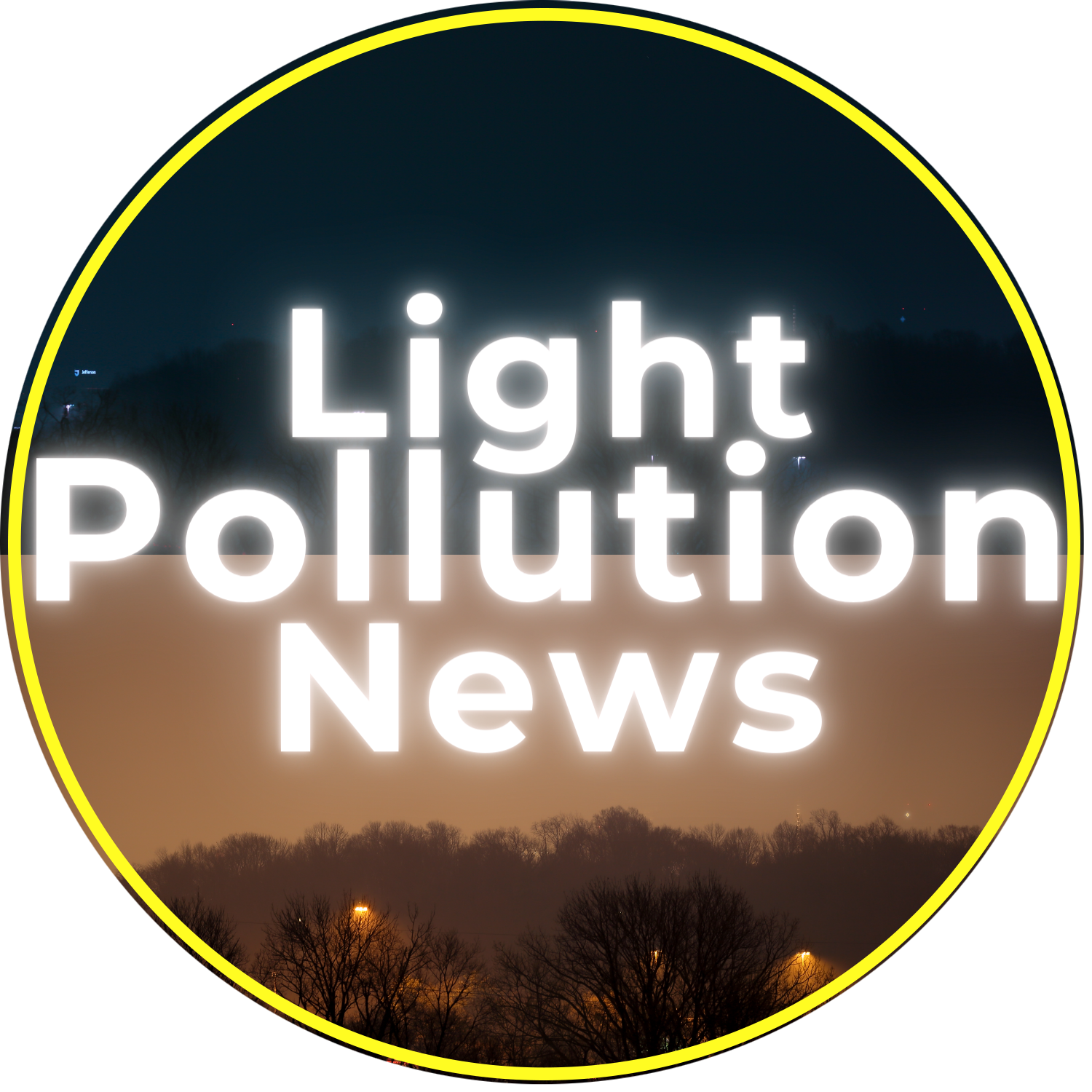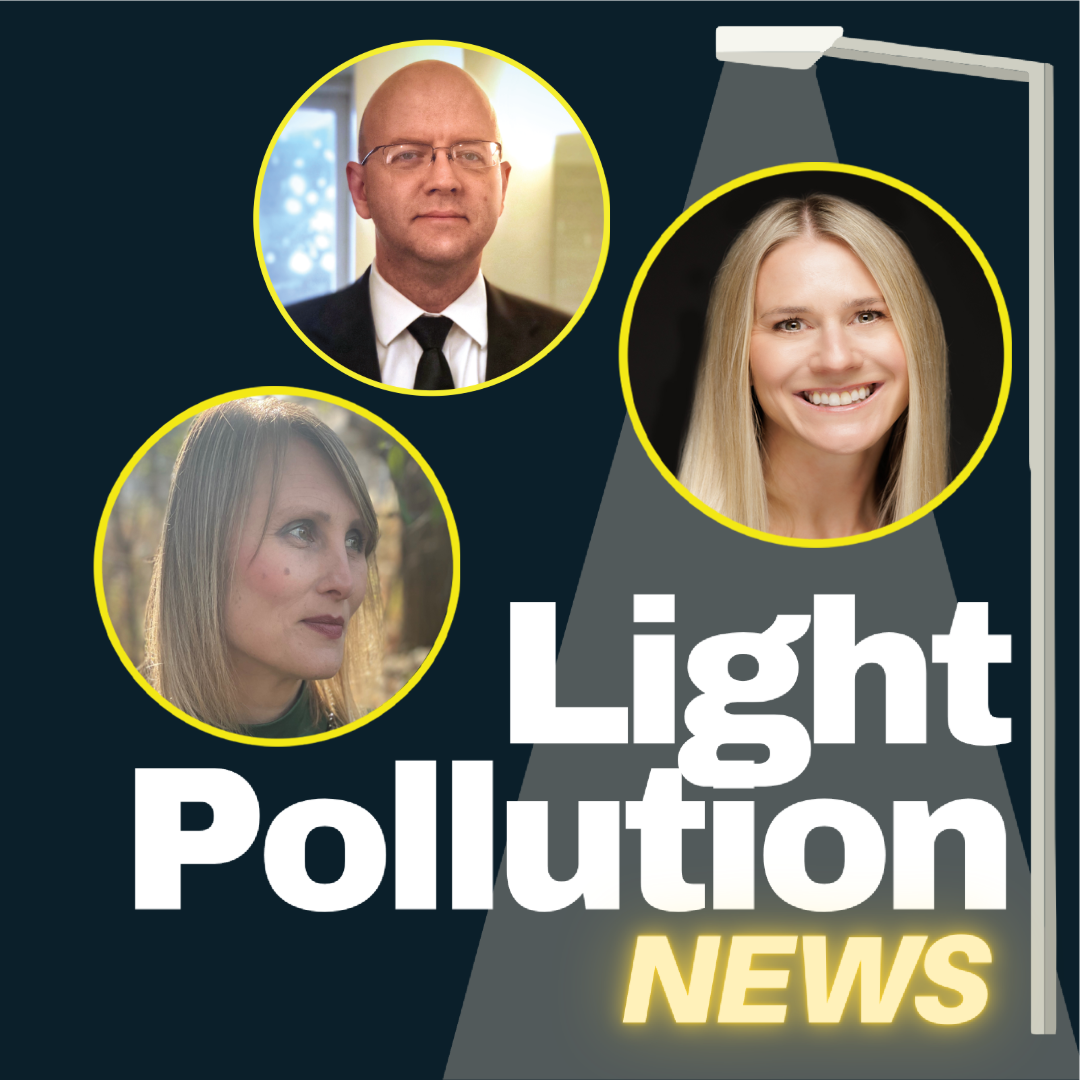
November 2025: 1 Lux!, Light Pollution News
Join our mailing list. Follow us at LinkedIn, Instagram, Facebook, & Tiktok.
This Episode:
This episode is one you won’t want to miss! A bridge turns its lights off for birds-you heard that right. More evidence for how our endless daytime affects plants. And, can artificial light at night influence puberty’s onset?
With me this episode are returning guests, jack of all trades, Mr. John Barentine, author and journalist, Lynne Peeples, and bird lover – aficionado, Tatsiana Thomson from Brome!
This is a good one! Here we go!
Like What You See and Hear? Consider Supporting the Show.
A hearty thank you to all of our paid supporters out there. You make this show possible.
For only the cost of one coffee each month, you can help us continue to grow. That’s $3 a month. If you like what we’re doing, if you think this adds value in any way, why not say thank you by becoming a supporter!
Why Support Light Pollution News?
- Receive quarterly invites to join as a live audience member for recordings with special Q&A sessions post recording with guests.
- Receive all of the news for that month via a special Supporter monthly mailer.
- The satisfaction that your support helps further critical discourse on this topic.
Support Light Pollution News!
Host:
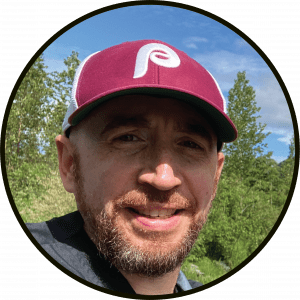
Guests:
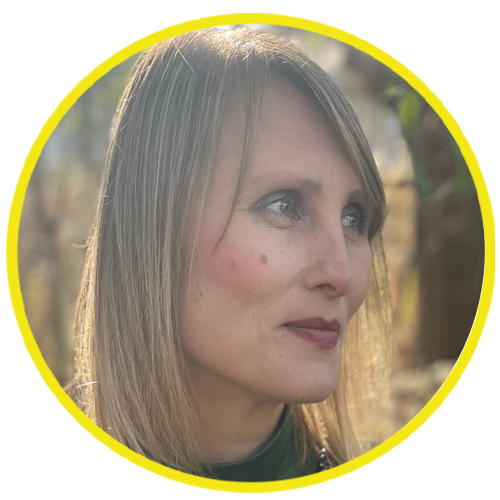


Tatsiana Thomson
Tatsiana Thomson is the Sales and Marketing Manager at Brome, the Canadian company behind the well-loved Squirrel Buster feeders. What began as a personal hobby quickly turned into a passion for sharing the joy of backyard birding with others. With a background in education, Tatsiana loves inspiring both bird lovers and retailers to learn, explore, and create welcoming spaces for birds. She brings a mix of storytelling, practical tips, and genuine enthusiasm to everything she does.
John Barentine
John Barentine is an astronomer, historian, author, science communicator, and dark-sky consultant. He earned a Ph.D. in astronomy from the University of Texas and is a member of the American Astronomical Society, the International Astronomical Union, and the Royal Astronomical Society. His interests include history, politics, and law.
Lynne Peeples
Lynne Peeples is a science journalist, speaker, and author of THE INNER CLOCK: Living in Sync with Our Circadian Rhythms (9/24/2024 Riverhead Books/Penguin Random House). Her writing has also appeared in The Guardian, The Los Angeles Times, Scientific American, Nature, The Atlantic, and other publications. Peeples herself has appeared on national and international television and radio, including MSNBC, NPR’s Fresh Air, and BBC News. Before becoming a journalist, she crunched numbers as a biostatistician for HIV clinical trials and environmental health studies. She holds master’s degrees in biostatistics from the Harvard School of Public Health and in science journalism from New York University.
Full Article List:
- The ultimate night sky IQ test, Kenna Hughes-Castleberry, Space.com.
- Environmental Commission applauds progress on bird-safe buildings, Amy Smith, Austin Monitor.
- Stuttgart supports Earth Night – lights out for a whole night, Dr. Jürgen Görres, Stuttgart.
- BC SPCA warns drivers after 18 owls hit on Vancouver Island roads last year, Mike Kelly, Victoria Buzz.
- Great River Bridge goes dark for birds, Hawk Eye.
- Puffins, petrels, and places: Understanding human perceptions to prevent seabird mortality due to light pollution, Ornithological Applications.
- Optimising nocturnal mammal surveys in tropical forests: when red light is the key, Mammal Research.
- Opinion: Flipping The Switch And Protecting Our Feathered Friends, Harvey Epstein and Kathy Nizzari, City Limits.
- Integrated of metabolome and transcriptome analysis reveals the effect of artificial light at night on Platanus orientalis L., BMC Plant Biology.
- Artificial light at night outweighs temperature in lengthening urban growing seasons, Nature Cities.
- The absolute ‘worst city in America’ to get good sleep is minutes away from NYC — and the Big Apple isn’t far behind, Asia Grace, New York Post.
- Association between exposure to outdoor light at night and sleep habits in Shahedieh Cohort Study: A cross-sectional analysis, Environmental Pollution.
- Light does not phase shift the circadian clock of subcutaneous adipose tissue in vitro, Biological Timing and Sleep.
- Brighter bedroom light at night predicts risk for earlier pubertal onset: a two-year longitudinal study, The Journal of Clinical Endocrinology & Metabolism.
- Association between indoor light at night and obesity among children and adolescents at different physical activity levels: a population-based cross-sectional study, BMC Public Health.
- Constellations Below: Lessons From Undersea Bioluminescence, Willow Defebaugh, Atmos.
Light Pollution News: November Highlights
Earth Night 2025
Earth Night took place on September 19, 2025, as part of a 2020 campaign by the nonprofit “Godparents of the Night.” Unlike Earth Hour, this voluntary initiative relies on participation from municipalities, businesses, and residences, primarily in Germany.
Austin Bird-Friendly Building Code
Austin City Council’s Watershed Protection Department, endorsed by the Environmental Commission, developed recommendations for bird-safe construction including:
- Full implementation of dark sky compliant lighting standards
- Bird-safe design materials for first 100 feet of building facades
- Material Threat Factor rating of 20 or less (compared to NYC’s requirement of 25 or less for 90% of first 75 feet)
The Material Threat Factor is a 0-100 scale created by the American Bird Conservancy measuring building danger to birds.
Burlington Bridge Lights-Out Success
Burlington, Iowa (population 23,000) turned off nonessential uplighting on the Great River Bridge across the Mississippi River for two days (September 26-27, 2025) during peak bird migration, guided by projections from Purdue University and Cornell Lab of Ornithology.
Pending Legislation
New York City – Int 0896-2024
Bill requiring office buildings and stores to keep non-essential exterior lights off from sunset to sunrise, with exceptions for small businesses, actively-used offices, landmarks, Times Square, and display windows (until midnight).
New York State – Dark Skies Protection Act (A4615)
Currently in Senate Committee on Environmental Conservation. Requirements include:
- Shielding clause mandating downward-lit fixtures for all buildings
- Non-compliant lights turned off between 11pm-sunrise
- Sports activities and amphitheaters prohibited from lighting past 11pm
Wildlife Research Findings
Nocturnal Mammal Surveys
Study in Mammal Research found thermal imaging with red light most effective for identifying tropical nocturnal mammals. White LED headlamps performed worst (missing 10 species), while red LED headlamps worked well as animals don’t register red wavelengths.
Seabird Conservation Attitudes
Research examined public perception of puffins versus storm petrels, identifying two groups:
- Traditionalists: Maximize human utility of wildlife (most negative associations)
- Mutualists: Believe in successful wildlife-human coexistence
Light pollution causes thousands of shorebirds to strand annually, particularly affecting fledglings drawn to artificial lights.
Owl Collision Risk
British Columbia SPCA reports owl injuries increase in autumn as owls hunt near roadsides in low light conditions.
Plant Biology Impacts
Urban Tree Leaf Retention (BMC Plant Biology)
Study of Plane trees (similar to American Sycamore) in China found streetlight exposure:
- Suppressed aging-related hormones
- Activated anti-aging auxin and cytokinin genes
- Kept leaves green into winter, potentially causing frost damage
Extended Growing Seasons (Nature Cities)
Satellite analysis of 428 cities worldwide revealed artificial light at night impacts urban plant cycles more than temperature:
- Spring arrives 6.4 days earlier in cities
- Autumn ends 7.1 days later compared to rural areas
- Artificial lighting grows exponentially toward dense urban centers while temperature increases gradually
Human Health Research
Sleep Duration Study (Environmental Pollution)
Study of 8,284 individuals (ages 35-70) in Yazd province, Iran found correlations between sky brightness and:
- Shorter sleep duration
- Higher sleep medication use
- Paradoxically, less trouble falling asleep
Note: Satellite-based studies cannot establish causation.
Subcutaneous Fat and Light Exposure (Biological Timing and Sleep)
Follow-up to 2017 research found white light exposure to mouse fat tissue for 4 hours did not shift circadian clocks, suggesting light influences fat tissue independent of circadian mechanisms.
Accelerated Puberty (Journal of Clinical Endocrinology & Metabolism)
Study of 886 children (ages 6-10) in Tianchang, China found:
- Each 30-minute increase in post-bedtime light exposure over 3 lux correlated with 9% increase in early development for boys, 12% for girls
- Light-exposed groups started puberty an average of 4 months earlier
Childhood Weight Gain (BMC Public Health)
Shanghai-based study of 628 children (ages 9-15) examined artificial light at night and weight gain. Findings show mixed statistical significance, with 72% exposed to over 1 lux during sleep. Researchers claimed 27% increased odds of weight gain from nighttime light exposure, though initial differences between dark control (28%) and light-exposed groups were not statistically significant.
Light Pollution News: November Read Along
Alright, let’s begin today with a quick quiz! This comes from Space.com.
Here’s a good little chunk of news that occurred this fall – an event called Earth Night took place on September 19th. Earth Night, not to be confused with Earth Hour, derived from a 2020 campaign by the nonprofit, the Godparents of the Night. Much like Earth Hour, it relies on voluntary buy in of participating municipalities, businesses, and residences. Earth Night is largely a German activity right now.
Some good news from down in the Lone Star State of Texas. Back in November of 2024, the Austin City Council charged the Watershed Protection Department with developing recommendations and guidelines for creating a bird friendly building code for new construction. In the same resolution, Austin endorsed the implementation of a Lights Out campaign for the city.
Well, the department has reported back, and it’s received the full endorsement of Austin’s Environmental Commission. The commission, I should note, built a working group of diversified stakeholders, including conservationists and developers. The recommendations, which include a full implementation of dark sky compliant lighting standards, also require bird-safe design materials for the first 100 feet of a facade, with what’s called a material threat factor rating of 20 or less.
For you at home who’s never heard of the ‘Material Threat Factor,’ it’s a scale built by the American Bird Conservancy to measure how dangerous a building is to birds. It ranges from 0-100, and currently in New York City, new builds are required to have a threat factor of 25 or less for 90% of the first 75 feet of construction.
In other news on the bird front, fall is one of my favorite times of the year, not just because of college football and the changing colors of the trees, but also because night finally arrives at a reasonable hour for stargazing! With earlier nights also comes increased risk of collisions with owls!
Per the British Columbia SPCA, owl injuries increase in the autumn as many owls hunt near roadsides in low light. So be on the lookout folks!
And for the first time in my tenure of doing this show, it looks like a city actually switched its obnoxious decorative bridge lighting off during bird migration. The city of Burlington, Iowa, population 23,000, turned off the nonessential lights on the Great River Bridge that spans the Mississippi River. The switch off, which amounted to turning off some excessive uplighting, occurred for two days on September 26th and 27th. It was spurred by bird migration projections from Purdue University and Cornell Lab of Ornithology. Bridge lighting is notoriously difficult to gain any type of compliance with regard to ecological lighting issues, so 2 days is no small feat.
Since we’re on the topic of Lights Out, for any of you New York based listeners, you may be interested in learning that both the city and the state need your help to push through some legislation, should you be so inclined.
First, on the city front, Int 0896-2024 is currently stagnating with the New York City Council. This bill requires office buildings and stores to keep non-essential exterior lights off from sunset to sunrise, with exceptions including for small businesses, for when offices are being actively utilized, landmark buildings, Times Square (of course), and store display windows, of which the latter can remain on until midnight (with additional holiday exclusions).
Second, the Dark Skies Protection Act, A4615, which is currently in the Senate Committee on Environmental Conservation. The act would require, among other things, a shielding clause designating only downward lit fixtures for all buildings, regardless of zoning type. If the lights don’t meet the standard, the law would require them to be turned off between 11pm to sunrise. It also has a recreational clause citing that sports activities and amphitheaters can’t be lit past 11pm. It goes without saying that there’s a long list of exceptions and exclusions to the law. This one was submitted in 2025.
There was a study that came out this month looking at how people viewed two types of seabirds, those being the beloved puffins and the lackluster storm petrels. The study looked at how to frame conservation efforts when one of the subjects isn’t beloved, and may even be scorned.
They found that in order to promote responsible policies, individuals have to connect on an emotional level with these birds, which has been a challenge for the storm petrel. Light pollution causes upwards of thousands of shorebirds to strand onshore annually. This stranding often starts at birth, whereby fledglings are drawn to the artificial lights, which act as a trap, disorienting the bird to its detriment and possibly demise.
Before we jump off of this study, I found this interesting. Researchers generally lumped people’s perceptions of wildlife into two camps: the ‘Traditionalist’, or someone who wishes to maximize human utility of wildlife…which predictably fostered the most negative associations for these birds; and the ‘Mutualists’ who believed in successful coexistence between wildlife and humans.
From the journal, Mammal Research, a team asked, what type of light works best for identifying tropical nocturnal mammals? They looked at white LED headlamps, red LED headlamps, and thermal imaging devices that utilized an additional red light. The answer, perhaps unsurprisingly, was the use of thermal imaging with red light.
White light scored the worst, for which the team failed to see 10 species when utilizing it. However, the red light scored pretty good, to which researchers surmised that the animals didn’t register the red wavelengths, thereby they weren’t disrupted in the same manner as a white light. Red light had the added bonus of illuminating animals’ eyes to brighter levels from a greater distance.
Lastly, on the ecology front tonight, let’s take a look at plants.
I have an interesting study out of BMC Plant Biology that looked at Plane trees in China. For you at home wondering what a ‘Plane’ tree is, it’s an actual type of tree – a Plane tree, that’s spelled like an airplane. These trees are in the same family as our American Sycamore.
Well, apparently, the Plane tree is a common urban tree. Researchers wanted to learn more about how artificial street light affected the leaf structure, so they sampled the normal yellowing leaves (which occurred away from the street lights), green leaves held onto by the trees under streetlights, and any green leaves found away from streetlights, for which in regards to the latter, there wasn’t an abundance of.
What they found was that the urban leaves ended up suppressing hormones related to aging and had a greater activation of anti-aging auxin and cytokinin genes. This was the opposite for the naturally yellowing leaves. The team surmised that keeping leaves green into the winter could create frost related damage for such trees.
A study published in Nature Cities used satellite analysis to review data for 428 cities around the world. It looked to see if artificial light at night and warmer temperatures (urban heat island effects) affected plants. What they found was that artificial light at night showed a greater impact on extending urban growing seasons than temperature did. Specifically, spring tended to occur 6.4 days sooner in cities and autumn ended 7.1 days later in cities compared with rural areas.
One of the interesting pieces of this study was that, while temperatures increased in urban areas, it was a more gradual increase. Conversely, artificial lighting grew exponentially toward denser regions of urban areas.
Let’s get into some health news, a weed company commissioned a “study” and found that, shockingly, the New York City vicinity was not conducive to a good night’s sleep – this included notable destinations like Newark and, by god, Jersey City.
A study from Environmental Pollution looked at how 8,284 individuals between 35-70 in Yazd province, Iran, slept. They assessed a generalized light pollution level via satellite data and surveyed participants about their sleep. Depending on one’s location in Yazd province, the sky brightness can swing quite widely. The researchers correlated sky brightness with shorter sleep duration and a higher use of sleep medications, though these folks, maybe from lack of sleep, had less trouble falling asleep. It should be noted that this study, like many of these satellite based papers, are unable to assign causation to its findings.
In a study from Biological Timing and Sleep, researchers looked at whether your internal clock could be affected by bright light simply hitting your skin and absorbing into your subcutaneous fat tissue. This was a follow up from a 2017 study that found blue light could actually change fat cell metabolism, thereby reducing fat storage and altering hormones. The study used mouse tissue samples exposed to white light for 4 hours at various times. They then tracked changes in the tissue and found that light exposure did not shift the circadian clock of the mouse; further, the light appears to exert influence on the fat tissue independent of the circadian timing mechanisms.
Next, a study makes the case for dark bedrooms. From the Journal of Clinical Endocrinology & Metabolism, artificial light at night appears to speed up puberty. This study looked at 886 children between 6 to 10 years old in Tianchang, Anhui in China. The children were assessed every 6 months. For each 30 minute post-bedtime increase in the duration of light over 3 lux, there was a 9% increase in early development for boys and 12% increase in early development for girls. On average, boys and girls in light exposed groups started 4 months earlier than the control.
Now, there’s a study here that I want to get your folks’ opinions on. It comes from BMC Public Health out of a research team based in Shanghai. The team attempted to assess if artificial light at night was a correlative factor in childhood weight gain. To partially control for this, they measured the child’s daily activity level. This involved 628 children between 9-15 years old. They used light meters next to beds from April through December of 2024. Sounds good, right?
Now here’s where the goggles get a bit foggy for me, and maybe you can point out where I’m wrong. 72% of the study participants were exposed to light in excess of 1 lux during sleep. Which means that 28% were essentially in a dark control group. What they found was that, given all factors being equal, the 28% dark control group didn’t have any statistical difference from the light group to start. However, under continuous and increasing exposure, they found a barely significant relationship but yet they list as their findings that higher light intensity was associated with increased weight gain; adding that every additional hour of the day with exposure over 1 lux drove this weight gain; and claiming that nighttime light exposure increased the odds of weight gain by 27%.
I want to leave you all with a quote from this episode. It derived from an article that I came across written by Willow Defebaugh in Atmos. This quote comes from Peter Thiel’s arch-nemesis and Antichrist hopeful, Greta Thunberg, “Once we start to act, hope is everywhere. So instead of looking for hope, look for action. Then and only then, hope will come.”
